
CHROMABLOX®
Culture
Artist Profile Nat Bowen
By Brooke Mazurek
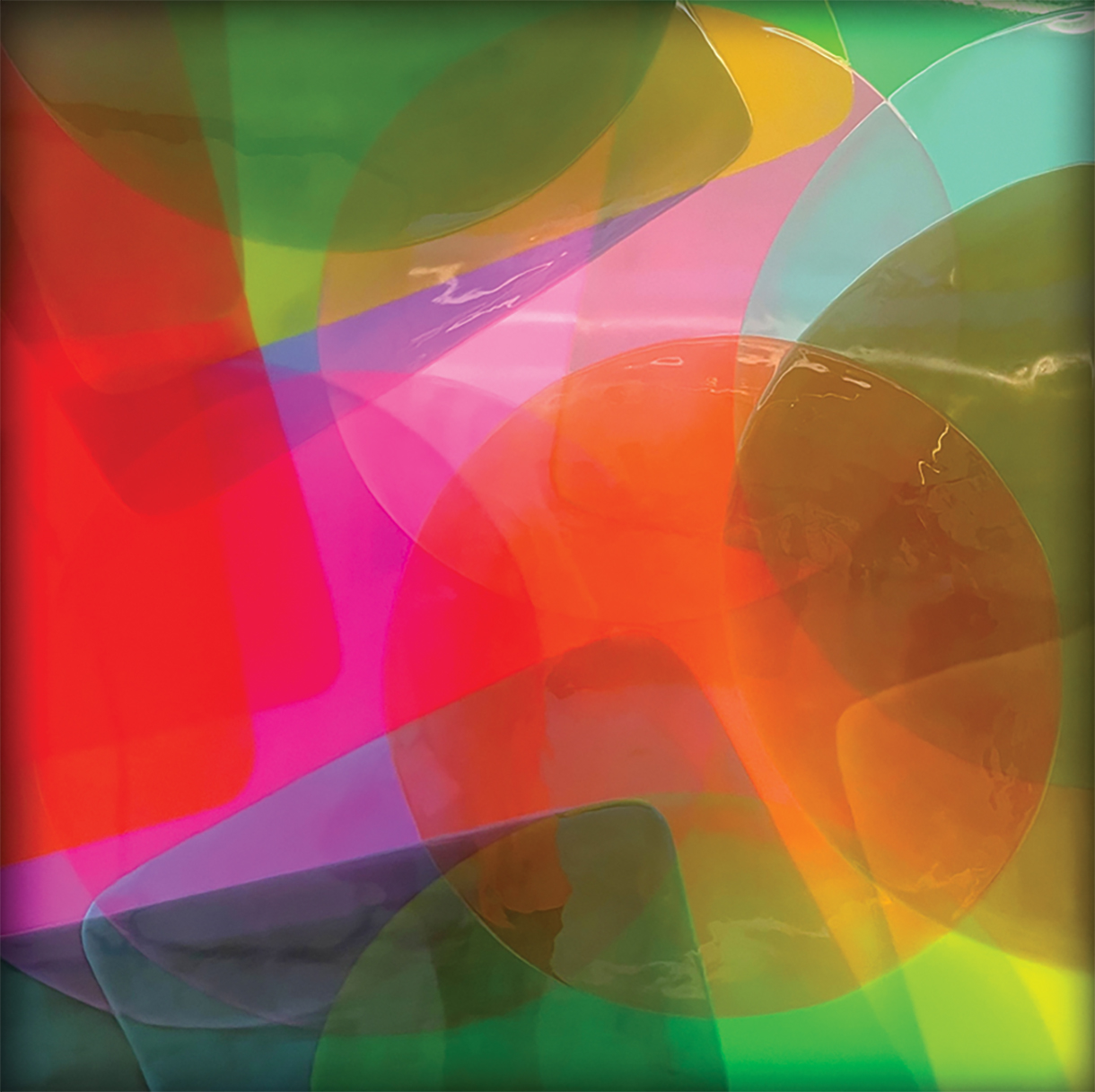
Candy
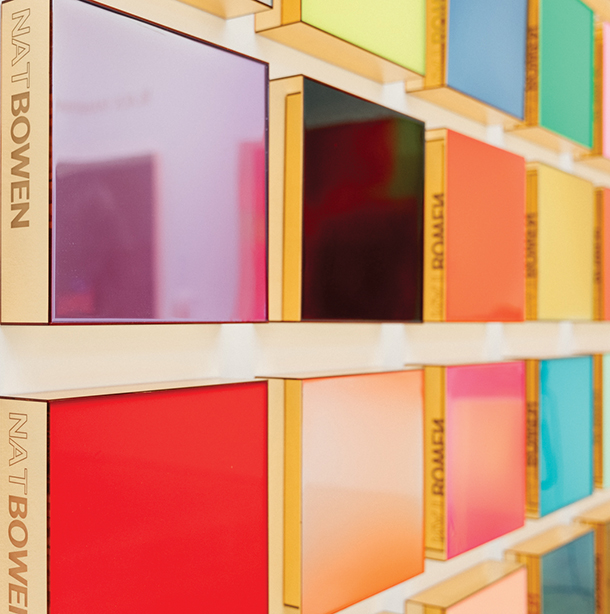
Undivided Fragments
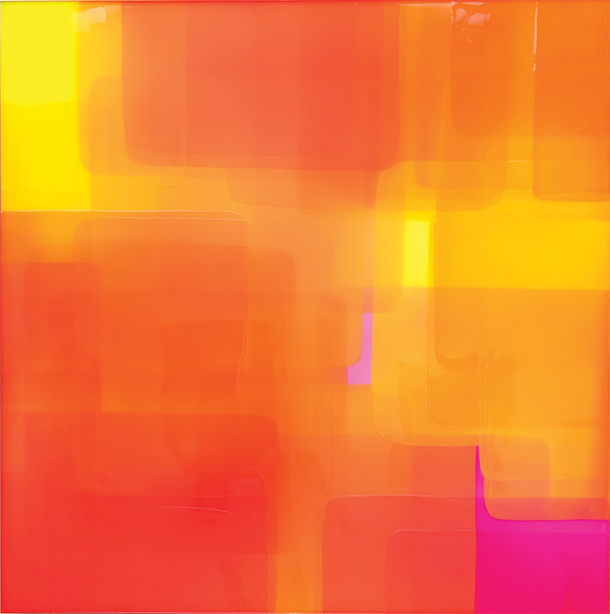
Blaze
Color my World
It was French poet Victor Hugo who wrote, “Wide horizons lead the soul to broad ideas.”For most of her adult life, abstract artist Nat Bowen looked out to high-rise buildings, cloudy skies, and dark palettes. “I hadn’t ever thought about leaving,” she says of her life in London. “I was born in England, and the mindset was: ‘I’m gonna stay in England.’”
Then the pandemic happened.
It was winter and depressing and in the midst of all the constriction and restriction, the lockdowns and holdups, Bowen’s husband was offered a job in Dubai. “I thought, ‘You know what? Let’s try it,’” she recalls.
She’d been there before, after all. She’d felt the Arabian heat, experienced the color, the beauty, the almost otherworldly, can-you-top-this architecture in a desert mecca known for the finest hotel rooms money can buy. But what Bowen hadn’t anticipated was the horizon. The completely boundless one she now finds herself face-to-face with each morning and evening.
“Every day, I’m in awe,” she says, peering out the window. “Where we are now, I get to look onto the sea and see as far to the horizon as possible. I watch the sun set—this big, glowing, neon ball in my favorite color, and every day I’m like ... ahhh, charge me up!” Her arms are wide open and you can hear it in her voice, a horizon expanded—words spoken with the animated, almost breathless quality that happens when someone falls in love anew with the world and its possibilities. You can also see it in Bowen’s work.

Blush
Her art is vibrant and alive, prismatic and textural. In her large-scale resin pieces, colors and geometric shapes bend and refract into one another, as if speaking a secret language heard through the human eye. Bowen identifies as a chromologist, someone immersed in the psychology of color, and at times she employs hues so saturated they look edible. There are glaciated blues and also unthawable ones, the kind that evoke the electric blue raspberry color of a pack of Gushers fruit snacks. To look at her epoxy resin piece Blush is to feel as though you’ve awoken inside the belly of an orchid. You think, “Who knew pink could be this pink?”
But a great deal of Bowen’s expertise also lies in her understanding of balance. Beside her brighter shades, she sometimes employs a muted pastel or a smokey earth tone—outlier colors that you eventually realize are carrying more weight than initially perceived. They anchor and brighten the bigger picture, and in doing so, convey a subtle yet potent message that the sum total is far greater than the individual. One shade leads to another.
The interplay mirrors Bowen’s own artistic path. There was no art school, no traditional teachers, and no waiting for a door from the insular contemporary art world to open to her. Art has been in the doing. Bowen learned how to make and sell artwork by using her hands and drawing from an eclectic palette of experiences spanning her work in the fashion industry and property development. Hers is the story of someone who has quit and changed jobs over and over again, someone in constant dialogue with what it means to live an aligned life, to see a main highway and look toward hills where there are no roads or paths. She’s carved her own while wearing the brightest neon Alexander Wang blouse you could possibly find.
But a great deal of Bowen’s expertise also lies in her understanding of balance. Beside her brighter shades, she sometimes employs a muted pastel or a smokey earth tone—outlier colors that you eventually realize are carrying more weight than initially perceived. They anchor and brighten the bigger picture, and in doing so, convey a subtle yet potent message that the sum total is far greater than the individual. One shade leads to another.
The interplay mirrors Bowen’s own artistic path. There was no art school, no traditional teachers, and no waiting for a door from the insular contemporary art world to open to her. Art has been in the doing. Bowen learned how to make and sell artwork by using her hands and drawing from an eclectic palette of experiences spanning her work in the fashion industry and property development. Hers is the story of someone who has quit and changed jobs over and over again, someone in constant dialogue with what it means to live an aligned life, to see a main highway and look toward hills where there are no roads or paths. She’s carved her own while wearing the brightest neon Alexander Wang blouse you could possibly find.
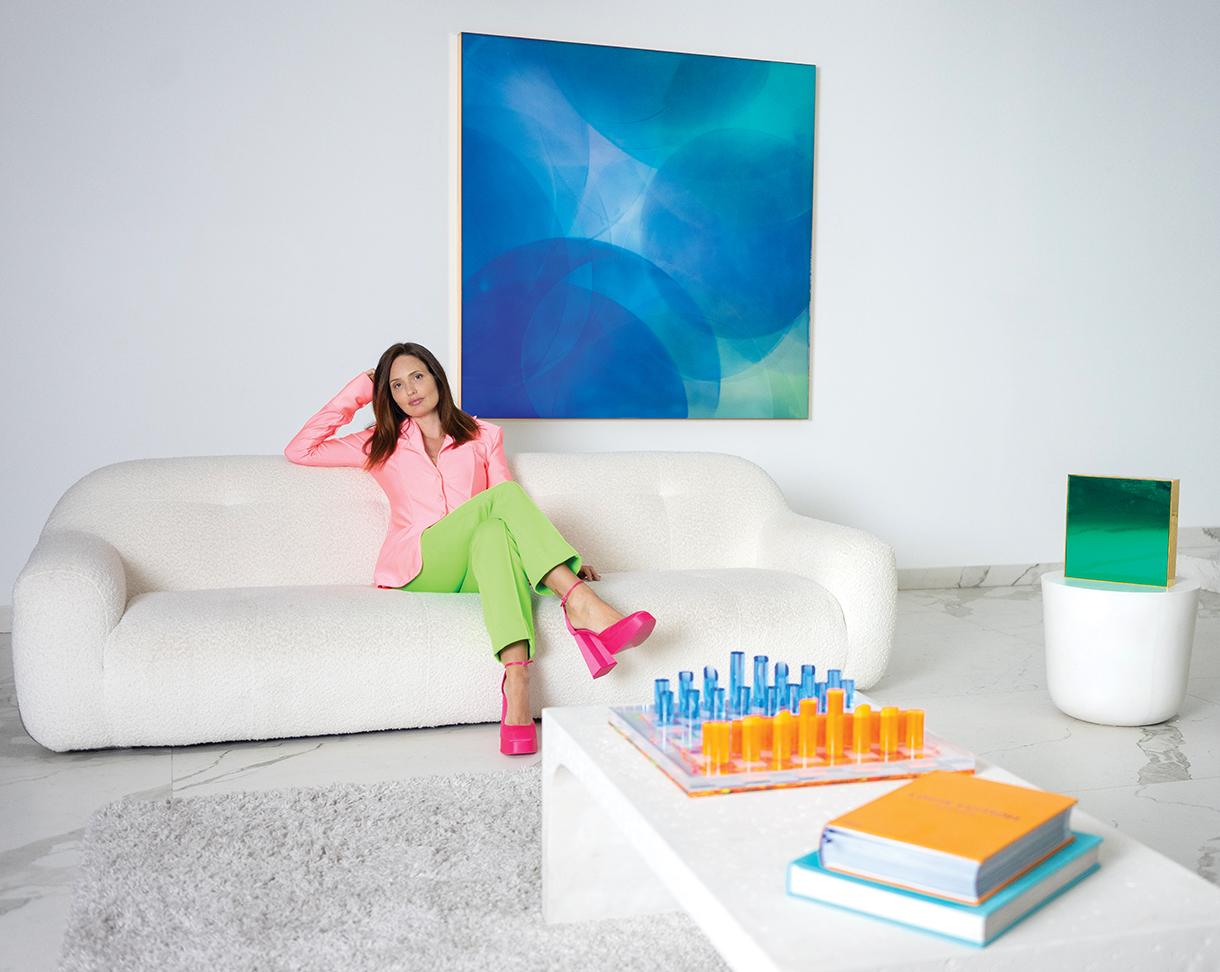
Big Blue
INTERVIEW WITH NAT BOWEN
What’s something people wouldn’t know about Dubai unless they lived there?I think there’s this misconception that it’s all bling-bling and parties. There’s definitely that, but it’s so peaceful and family oriented. We’ve had a baby who just turned 1 and this place is so much more set up for families and children than back home.
Peoples’ mindsets are also super positive. Here, it’s like the land of opportunity. People really think big, and for creative minds that’s a great quality. It’s “dream big, and then go even bigger.”
What are you currently working on?
There’s a beach club project that’s been the biggest I’ve done so far. It’s opening on the Palm Jumeirah in Dubai. Part of the project is the Chroma blocks, which is the first sculpture I’ve done and the first thing I’ve done outside. Part of the challenge has been figuring out how I can get those intense, vibrant colors to withstand the elements here. It’s just been a lot of development, which I’ve loved. I’ve gone from paintings to now thinking: “OK, how can we take my ideas even bigger?”

Nat Bowen x McLaren Artura Art Car
You also did a collaboration with McLaren in Dubai.
The design director [in England] discovered me on Instagram and loved what I was doing. He felt like there was a synergy with our brands, so I went to their [headquarters], and I don’t know if you’ve ever been, but it’s almost like a spaceship that landed in the British countryside. It’s this James Bond kind of place that you can’t take photos of. He and I were talking about doing something together and literally after that meeting, COVID popped its head up and it just didn’t materialize. I moved to Dubai and the marketing director here said, “Oh, I love what you do, let’s do something here!” That was in October and by the end of February I had an exhibition with them. In Dubai, it’s like, “Let’s do it! And let’s do it now!” It all happened super quick, and it really put me on the map here.
What’s your creative process like?
My studio is at home, which is really good because my work is a very slow process. I paint layer upon layer with resin, which is a two-part mix. So you mix it up, it starts to have a chemical reaction, and then you’ve got a certain amount of working time with it, maybe 45 minutes at most, before it starts to cure. So I mix it, I pigment it, and then I paint it all freehand with a paint brush. It’s very physical. It’s almost like dancing while you’re painting. And then you’ve got this downtime, where it needs to cure for a few hours before you can go back in to do the next layer. And I just love it. It’s my meditation, it’s my exercise, it’s everything for me. All you really want in life is freedom to live how you want to live, and to get to the point in life where you can wake up in the morning and go about your day in the way you’re choosing.
The design director [in England] discovered me on Instagram and loved what I was doing. He felt like there was a synergy with our brands, so I went to their [headquarters], and I don’t know if you’ve ever been, but it’s almost like a spaceship that landed in the British countryside. It’s this James Bond kind of place that you can’t take photos of. He and I were talking about doing something together and literally after that meeting, COVID popped its head up and it just didn’t materialize. I moved to Dubai and the marketing director here said, “Oh, I love what you do, let’s do something here!” That was in October and by the end of February I had an exhibition with them. In Dubai, it’s like, “Let’s do it! And let’s do it now!” It all happened super quick, and it really put me on the map here.
What’s your creative process like?
My studio is at home, which is really good because my work is a very slow process. I paint layer upon layer with resin, which is a two-part mix. So you mix it up, it starts to have a chemical reaction, and then you’ve got a certain amount of working time with it, maybe 45 minutes at most, before it starts to cure. So I mix it, I pigment it, and then I paint it all freehand with a paint brush. It’s very physical. It’s almost like dancing while you’re painting. And then you’ve got this downtime, where it needs to cure for a few hours before you can go back in to do the next layer. And I just love it. It’s my meditation, it’s my exercise, it’s everything for me. All you really want in life is freedom to live how you want to live, and to get to the point in life where you can wake up in the morning and go about your day in the way you’re choosing.
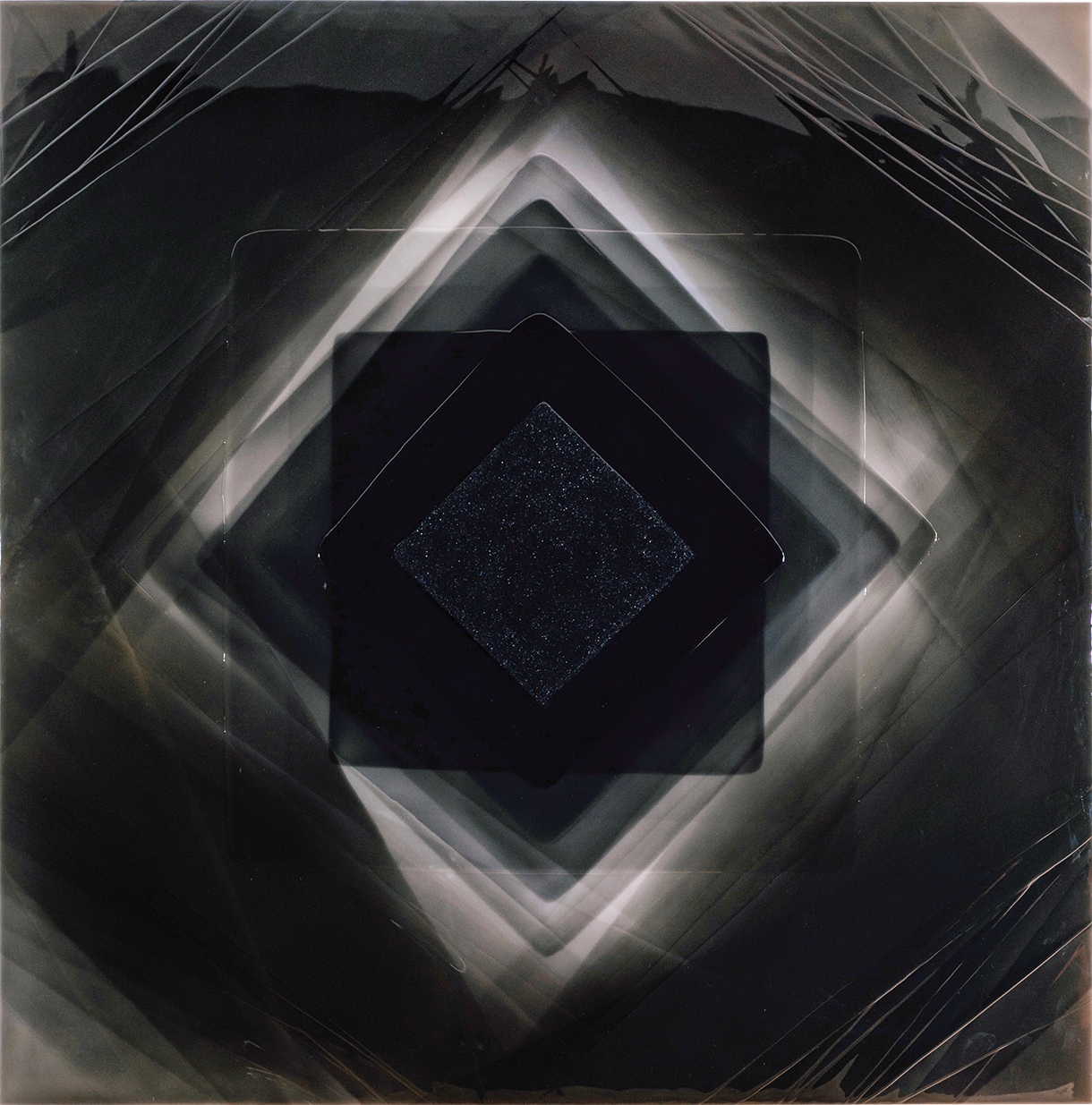
Black Diamond
How did you discover resin? It’s such a unique medium.
It’s the only medium I’ve ever painted with. It brings colors to life in a way that no other medium quite does. It allows me to have transparency with the colors as well, so the layers build on top of each other—which is what gives the depth. There’s also a viscosity to it, a thickness to each layer. I love that when you’re walking past a painting, you get the reflection of the light and it’s almost like the piece is alive. There’s movement.
Where do you source the pigment?
I started out using only synthetic pigments and then I started looking into natural, precious, or rare pigments. I’ve got a blue piece that has the purest lapis lazuli from Afghanistan and Egyptian blue from Babylon times. There was a piece, called Black Diamond, which was the first one I sold when I moved to Dubai, that has 1,000 carats of black diamond set in the center of it. I also sourced and painted 4.6-billion-year-old meteorite dust into it. And there’s a piece I’ve just done for a collector in Burgundy, the wine region in France. There was a yellow ochre pigment that I sourced from when the region was known for its mining. When pieces are commissioned, I try to do storytelling with the elements.
Is there a pigment you haven’t worked with that you’d love to get your hands on?
Dust from the moon. I want to paint a moon piece. But then, in saying that, there’s something so sacred about the moon. I shouldn’t be taking from it.
You’re known as the “Queen of Color.” How do you feel about black?
I think black gets a hard time. It’s one of those colors that people are like, “It’s depressing, it’s associated with death, it’s morbid.” For me, black is power, strength, independence. It’s all in how you use it, I think. A lot of the pieces where I incorporate black tend to be more circular to soften the color—so it’s almost like you’re falling into the middle of the painting. Deep, dark water. Even in my colorful pieces, you’ll often find black. It’s grounding. There are certain high-energy colors like yellows that are quite intense for your eye and brain to process. So when you’ve got colors like that, you need balance.
It’s the only medium I’ve ever painted with. It brings colors to life in a way that no other medium quite does. It allows me to have transparency with the colors as well, so the layers build on top of each other—which is what gives the depth. There’s also a viscosity to it, a thickness to each layer. I love that when you’re walking past a painting, you get the reflection of the light and it’s almost like the piece is alive. There’s movement.
Where do you source the pigment?
I started out using only synthetic pigments and then I started looking into natural, precious, or rare pigments. I’ve got a blue piece that has the purest lapis lazuli from Afghanistan and Egyptian blue from Babylon times. There was a piece, called Black Diamond, which was the first one I sold when I moved to Dubai, that has 1,000 carats of black diamond set in the center of it. I also sourced and painted 4.6-billion-year-old meteorite dust into it. And there’s a piece I’ve just done for a collector in Burgundy, the wine region in France. There was a yellow ochre pigment that I sourced from when the region was known for its mining. When pieces are commissioned, I try to do storytelling with the elements.
Is there a pigment you haven’t worked with that you’d love to get your hands on?
Dust from the moon. I want to paint a moon piece. But then, in saying that, there’s something so sacred about the moon. I shouldn’t be taking from it.
You’re known as the “Queen of Color.” How do you feel about black?
I think black gets a hard time. It’s one of those colors that people are like, “It’s depressing, it’s associated with death, it’s morbid.” For me, black is power, strength, independence. It’s all in how you use it, I think. A lot of the pieces where I incorporate black tend to be more circular to soften the color—so it’s almost like you’re falling into the middle of the painting. Deep, dark water. Even in my colorful pieces, you’ll often find black. It’s grounding. There are certain high-energy colors like yellows that are quite intense for your eye and brain to process. So when you’ve got colors like that, you need balance.
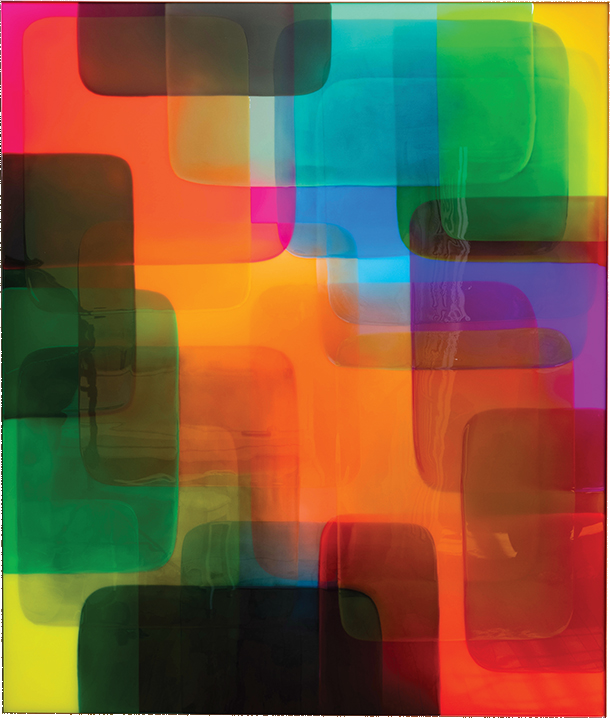
Vibe
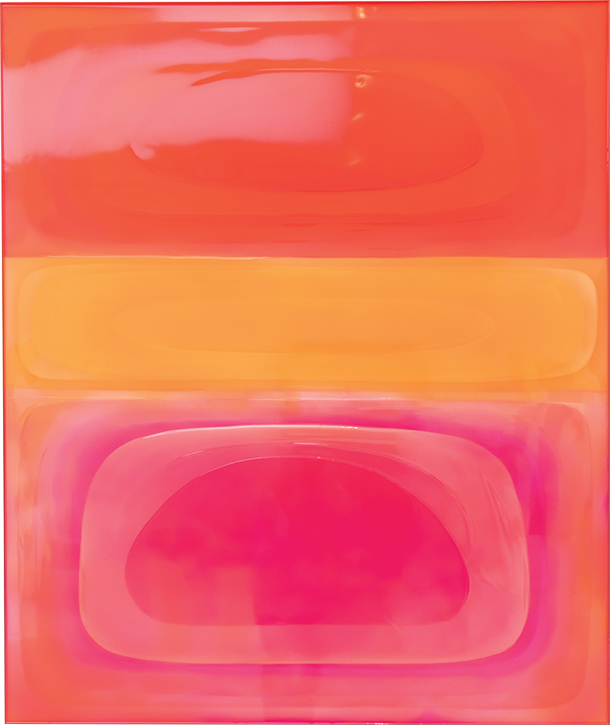
Love Bubble
When in your life did you realize there was this connection with color?
My mum says always. I was born in the ’80s but grew up in the ’90s. And for me, the ’90s were a bit like the ’70s in terms of colors. I remember lime green and orange, and all of these colors being such a thing. I used to paint my nails, every nail a different color. I changed the color on the walls of my bedroom I don’t know how many times. I just wanted to express myself through color. My language is color and it comes out in my art; it comes out in what I wear.
What was your journey to becoming an artist like?
It wasn’t a traditional one. I went to a very academic secondary school, and I’d been pushed down this more academic path—not by my parents, but by the school. My mum was a design teacher, and I remember she came home one day with this book of courses offered at Newcastle [University]. I didn’t know what I wanted to do and she said, “What about fashion?”
As early as I can remember, I was always making things—whether it was painting or drawing. My grandmother taught me how to sew. And I was like, “I can’t go and do fashion, I don’t know what I’m doing.” And my mum said, “You know what you’re doing.”
I ended up completing a two-year college course in fashion, and then went to the London College of Fashion. It moved me from the Midlands to London. After that, I went into a design role, but it wasn’t the right path for me. Though I didn’t know what I wanted to do, I was always fearless with trying things. So I quit. I went into fashion buying and no, that wasn’t right for me either. I’d modeled since I was a teenager, so I fell back into that for a little bit, which was great. I got to work with different creative teams and it gave me that freedom.
I basically spent my twenties really working out who I was, and what I wanted to do. And it was a gift, in a sense. I think so often people go down this path of, “You go to university and you get a job, work your way up a ladder, and get stuck in something you didn’t intend to get stuck in.”
I eventually ended up in a job for a property developer, and I didn’t work there very long, but it gave me this insight into the world of luxury and how people designed beautiful, contemporary spaces. I quit to start painting. But because I’d made some good connections within that world, they said, “We need some artworks for one of our show homes. We’ll commission you to do some pieces.”
It made me get set up quite quickly in a professional sense. It was like, “OK, let’s get a proper studio, let’s really go for this, and let’s really try to make the thing I love. Let’s get some resin, let’s get a paintbrush, and let’s see what happens.”
With being self-taught, is there someone you consider to be your great teacher?
As cliché as it sounds, it would be my mum. I’ve always seen both my mum and dad work with their hands. We’re all very practical. If something’s broken, give it to me and I’ll fix it. There’s an entrepreneurial aspect to my personality as well. I consider myself a businesswoman. I’m self-represented, and my mum’s mum did several jobs. She was a hairdresser, a caretaker, all of these different things throughout her lifetime, and I take inspiration from her.
I think people always think as an artist you shouldn’t talk about the commercial or the marketing side of things. You’re supposed to be this tortured soul in your studio, and it’s like, “No, I have to think about that!” For me to continue doing what I do, I have to make money or else I can’t do it.
Are there resources you listen to or read for business insight?
I love listening to Steven Bartlett’s Diary of a CEO podcast. They’re two hours long, and it’s really interesting to hear about these businesspeoples’ journeys. So often they haven’t gone down a traditional path and then end up selling their companies for a billion dollars. I find it really inspiring. There are a lot of people who would say, “Wow, Nat. You’ve done it! You’re killing it, you’re smashing it!” And I’m like, “I haven’t done it! I’ve just got going!” I never want to feel like I’m at the finish line or I’ve reached the peak. It’s like, “No, no, no—there’s a whole lot more in here that needs to come out!”
All images courtesy Nat Bowen.
My mum says always. I was born in the ’80s but grew up in the ’90s. And for me, the ’90s were a bit like the ’70s in terms of colors. I remember lime green and orange, and all of these colors being such a thing. I used to paint my nails, every nail a different color. I changed the color on the walls of my bedroom I don’t know how many times. I just wanted to express myself through color. My language is color and it comes out in my art; it comes out in what I wear.
What was your journey to becoming an artist like?
It wasn’t a traditional one. I went to a very academic secondary school, and I’d been pushed down this more academic path—not by my parents, but by the school. My mum was a design teacher, and I remember she came home one day with this book of courses offered at Newcastle [University]. I didn’t know what I wanted to do and she said, “What about fashion?”
As early as I can remember, I was always making things—whether it was painting or drawing. My grandmother taught me how to sew. And I was like, “I can’t go and do fashion, I don’t know what I’m doing.” And my mum said, “You know what you’re doing.”
I ended up completing a two-year college course in fashion, and then went to the London College of Fashion. It moved me from the Midlands to London. After that, I went into a design role, but it wasn’t the right path for me. Though I didn’t know what I wanted to do, I was always fearless with trying things. So I quit. I went into fashion buying and no, that wasn’t right for me either. I’d modeled since I was a teenager, so I fell back into that for a little bit, which was great. I got to work with different creative teams and it gave me that freedom.
I basically spent my twenties really working out who I was, and what I wanted to do. And it was a gift, in a sense. I think so often people go down this path of, “You go to university and you get a job, work your way up a ladder, and get stuck in something you didn’t intend to get stuck in.”
I eventually ended up in a job for a property developer, and I didn’t work there very long, but it gave me this insight into the world of luxury and how people designed beautiful, contemporary spaces. I quit to start painting. But because I’d made some good connections within that world, they said, “We need some artworks for one of our show homes. We’ll commission you to do some pieces.”
It made me get set up quite quickly in a professional sense. It was like, “OK, let’s get a proper studio, let’s really go for this, and let’s really try to make the thing I love. Let’s get some resin, let’s get a paintbrush, and let’s see what happens.”
With being self-taught, is there someone you consider to be your great teacher?
As cliché as it sounds, it would be my mum. I’ve always seen both my mum and dad work with their hands. We’re all very practical. If something’s broken, give it to me and I’ll fix it. There’s an entrepreneurial aspect to my personality as well. I consider myself a businesswoman. I’m self-represented, and my mum’s mum did several jobs. She was a hairdresser, a caretaker, all of these different things throughout her lifetime, and I take inspiration from her.
I think people always think as an artist you shouldn’t talk about the commercial or the marketing side of things. You’re supposed to be this tortured soul in your studio, and it’s like, “No, I have to think about that!” For me to continue doing what I do, I have to make money or else I can’t do it.
Are there resources you listen to or read for business insight?
I love listening to Steven Bartlett’s Diary of a CEO podcast. They’re two hours long, and it’s really interesting to hear about these businesspeoples’ journeys. So often they haven’t gone down a traditional path and then end up selling their companies for a billion dollars. I find it really inspiring. There are a lot of people who would say, “Wow, Nat. You’ve done it! You’re killing it, you’re smashing it!” And I’m like, “I haven’t done it! I’ve just got going!” I never want to feel like I’m at the finish line or I’ve reached the peak. It’s like, “No, no, no—there’s a whole lot more in here that needs to come out!”
All images courtesy Nat Bowen.




